RENAISSANCE ARTIST AND THEIR MASTERPIECES |
| credits to:Wikipedia Michelangelo di Lodovico Buonarroti Simoni (6 March 1475 – 18 February 1564) was an Italian sculptor, painter, architect, poet, and engineer of the High Renaissance who exerted an unparalleled influence on the development of Western art. Considered as the greatest living artist in his lifetime, he has since been held as one of the greatest artists of all time.Despite making few forays beyond the arts, his versatility in the disciplines he took up was of such a high order that he is often considered a contender for the title of the archetypal Renaissance man, along with his fellow Italian Leonardo da Vinci.(credits to:Wikipedia) For more information click the link below. https://en.wikipedia.org/wiki/Michelangelo MASTERPIECES:  credits to:Wikipedia Pietà (Italian: [pjeˈta*]; 1498–1499) is a work of Renaissance sculpture by Michelangelo Buonarroti, housed in St. Peter's Basilica, Vatican City. It is the first of a number of works of the same theme by the artist. The statue was commissioned for the French Cardinal Jean de Bilhères, who was a representative in Rome. The sculpture, in Carrara marble, was made for the cardinal's funeral monument, but was moved to its current location, the first chapel on the right as one enters the basilica, in the 18th century. It is the only piece Michelangelo ever signed.(credits to:Wikipedia) For more information click the link below. https://en.wikipedia.org/wiki/Piet%C3%A0_(Michelangelo) 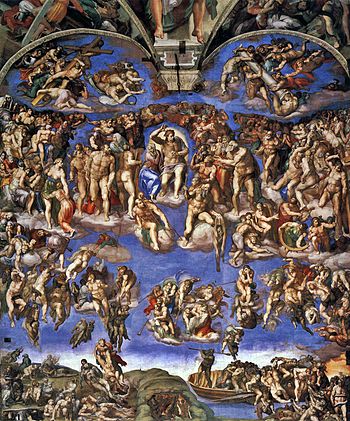 credits to:Wikipedia The Last Judgement (Italian: Il Giudizio Universale), is a fresco by the Italian Renaissance master Michelangelo executed on the altar wall of the Sistine Chapel in Vatican City. It is a depiction of the Second Coming of Christ and the final and eternal judgment by God of all humanity. The souls of humans rise and descend to their fates, as judged by Christ surrounded by prominent saints including Saints Catherine of Alexandria,Peter, Lawrence, Bartholomew, Paul, Sebastian, John the Baptist, and others.(credits to:Wikipedia) For more information click the link below. https://en.wikipedia.org/wiki/The_Last_Judgment_(Michelangelo)  credits to:Wikipedia The Sistine Chapel ceiling, painted by Michelangelo between 1508 and 1512, is a cornerstone work of High Renaissance art.The ceiling's various painted elements form part of a larger scheme of decoration within the Chapel, which includes the large fresco The Last Judgment on the sanctuary wall, also by Michelangelo, wall paintings by several leading painters of the late 15th century including Sandro Botticelli, Domenico Ghirlandaio and Pietro Perugino, and a set of large tapestries by Raphael, the whole illustrating much of the doctrine of the Catholic Church.(credits to:Wikipedia) For more information click the link below. https://en.wikipedia.org/wiki/Sistine_Chapel_ceiling  credits to:Wikipedia Tiziano Vecelli or Tiziano Vecellio (c. 1488/1490– 27 August 1576), known in English as Titian (/ˈtɪʃən/), was an Italian painter, the most important member of the 16th-century Venetian school. He was born in Pieve di Cadore, near Belluno (inVeneto, Republic of Venice). During his lifetime he was often called da Cadore, taken from the place of his birth.During the course of his long life, Titian's artistic manner changed drastically but he retained a lifelong interest in color. Although his mature works may not contain the vivid, luminous tints of his early pieces, their loose brushwork and subtlety of tone are without precedent in the history of Western painting and He was noted for his mastery of colour.(credits to:Wikipedia) For more information click the link below. https://en.wikipedia.org/wiki/Titian MASTERPIECES: 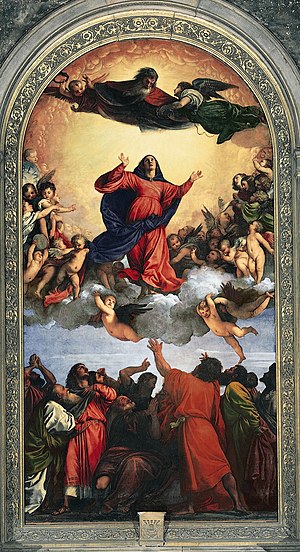 credits to:Wikipedia Assumption of the Virgin is a large oil painting by Italian Renaissance artist Titian, executed in 1516–1518. It is located on the high altar in the Basilica di Santa Maria Gloriosa dei Frari in Venice, being the largest altarpiece in the city.The Assumption of the virgin depicted in the painting is celebrated every year on August 15 and is a defined dogma of the Catholic church.(credits to:Wikipedia) For more information click the link below. https://en.wikipedia.org/wiki/Assumption_of_the_Virgin_(Titian)  credits to:Wikipedia Salome is an oil painting by Italian late Renaissance painter Titian, dated to around 1515 and now held at the Doria Pamphilj Galleryin Rome.The painting is set in a dark room, with, on the right, an arch opening to a blue sky surmounted by a sculpted angel. It depicts Salome holding the head of St. John the Baptist, helped by a young assistant.The woman, an example of idealized beauty, was portrayed by Titian in numerous other works of the period, including the Woman at the Mirror, Violante, Vanity and Sacred and Profane Love.(credits to:Wikipedia) For more information click the link below. https://en.wikipedia.org/wiki/Salome_(Titian)  credits to:Wikipedia Bacchus and Ariadne (1522–1523) is an oil painting by Titian. It is one of a cycle of paintings on mythological subjects produced for Alfonso I d'Este, Duke of Ferrara, for the Camerino d'Alabastro – a private room in his palazzo in Ferrara decorated with paintings based on classical texts. An advance payment was given to Raphael, who originally held the commission for the subject of a Triumph of Bacchus. At the time of Raphael's death in 1520, only a preliminary drawing was completed and the commission was then handed to Titian. In the case of Bacchus and Ariadne, the subject matter was derived from the Roman poets Catullus and Ovid. The painting, considered one of Titian's greatest works, now hangs in the National Gallery in London.(credits to:Wikipedia) For more information click the link below. https://en.wikipedia.org/wiki/Bacchus_and_Ariadne  credits to:Wikipedia Donato di Niccolò di Betto Bardi (c. 1386 – December 13, 1466), better known as Donatello (Italian: [donaˈtɛllo]), was an early Renaissance sculptor from Florence. He studied classical sculpture, and used this to develop a fully Renaissance style in sculpture, which his periods in Rome, Padua and Siena introduced to other parts of Italy over his long and productive career. He worked in stone, bronze, wood, clay, stucco and wax, and had several assistants, with four perhaps a typical number. Though his most famous works are mostly statues in the round, he developed a new, very shallow, type of bas-relief for small works, and a good deal of his output was larger architectural reliefs.(credits to:Wikipedia) For more information click the link below. https://en.wikipedia.org/wiki/Donatello MASTERPIECES: 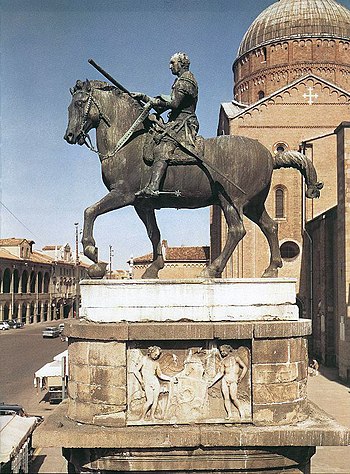 credits to:Wikipedia The Equestrian Statue of Gattamelata is a sculpture by Italian early Renaissance artist Donatello, dating from 1453,[1] located in the Piazza del Santo in Padua, Italy, today. It portrays the Renaissance condottiero Erasmo da Narni, known as "Gattamelata", who served mostly under the Republic of Venice, which ruled Padua at the time.(credits to:Wikipedia) For more information click the link below. https://en.wikipedia.org/wiki/Equestrian_statue_of_Gattamelata  credits to:Wikipedia David is the title of two statues of the biblical hero by the Italian early Renaissance sculptor Donatello, an early work in marble of a clothed figure (1408-09), and a far more famous bronze figure that is nude between its helmet and boots, and dates to the 1430s or later. Both are now in the Museo Nazionale del Bargello in Florence.(credits to:Wikipedia) For more information click the link below. https://en.wikipedia.org/wiki/David_(Donatello) 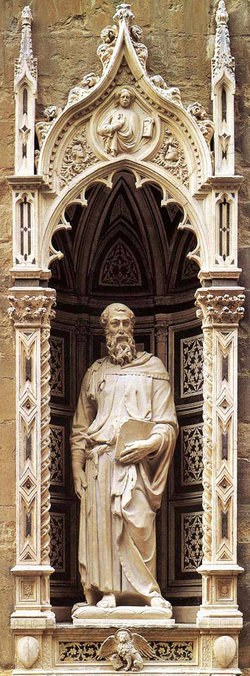 credits to:Wikipedia Donatello's Saint Mark (1411–1413) is a marble statue that stands approximately seven feet and nine inches high in an exterior niche of the Orsanmichele church, Florence. Donatello was commissioned by the linen weavers' guild to complete three pieces for the project. St. Mark was the first of his contributions. The niche itself was not of Donatello's hand, but created most probably by two stone carvers named Perfetto di Giovanni and Albizzo di Pietro. Today, a copy of the statue stands in the original's place, while the real St. Mark is housed inside the church's museum.(credits to:Wikipedia) For more information click the link below. https://en.wikipedia.org/wiki/Saint_Mark_(Donatello)  credits to:Wikipedia Raffaello Sanzio da Urbino (Italian: [raffaˈɛllo ˈsantsjo da urˈbiːno]; April 6 or March 28, 1483 – April 6, 1520),[3] known as Raphael (/ˈræfeɪəl/, US /ˈræfiəl, ˌrɑːfaɪˈɛl/), was an Italian painter and architect of the High Renaissance. His work is admired for its clarity of form, ease of composition, and visual achievement of the Neoplatonic ideal of human grandeur. Together with Michelangelo and Leonardo da Vinci, he forms the traditional trinity of great masters of that period.(credits to:Wikipedia) For more information click the link below. https://en.wikipedia.org/wiki/Raphael MASTERPIECES:  credits to:Wikipedia The School of Athens, or Scuola di Atene in Italian, is one of the most famous frescoes by the Italian Renaissance artist Raphael. It was painted between 1509 and 1511 as a part of Raphael's commission to decorate the rooms now known as the Stanze di Raffaello, in the Apostolic Palace in the Vatican. The Stanza della Segnatura was the first of the rooms to be decorated, and The School of Athens, representing Philosophy, was probably the second painting to be finished there, after La Disputa (Theology) on the opposite wall, and the Parnassus (Literature). The picture has long been seen as "Raphael's masterpiece and the perfect embodiment of the classical spirit of the Renaissance.(credits to:Wikipedia) For more information click the link below. https://en.wikipedia.org/wiki/The_School_of_Athens 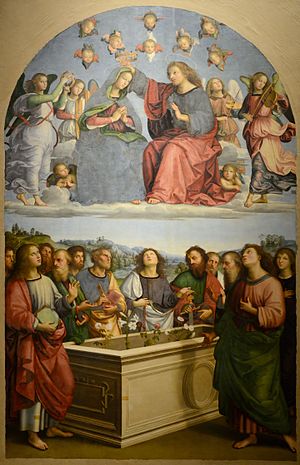 credits to:Wikipedia The Oddi Altarpiece is an altarpiece of the Coronation of the Virgin painted in 1502-1504[1] by the Italian Renaissance master Raphael for the altar of the Oddi family chapel in the church of San Francesco al Prato in Perugia, Italy, now in theVatican Pinacoteca.(credits to:Wikipedia) For more information click the link below. https://en.wikipedia.org/wiki/Oddi_Altarpiece_(Raphael)  credits to:Wikipedia The Marriage of the Virgin, also known as Lo Sposalizio, is an oil painting by Italian High Renaissance artist Raphael. Completed in 1504 for the Franciscan church of San Francesco, Città di Castello, the painting depicts a marriage ceremony between Mary and Joseph. It changed hands several times before settling in 1806 at the Pinacoteca di Brera.(credits to:Wikipedia) For more information click the link below.https://en.wikipedia.org/wiki/The_Marriage_of_the_Virgin_(Raphael)  credits to:Wikipedia Leonardo di ser Piero da Vinci, more commonly Leonardo da Vinci, (Italian: [leoˈnardo da (v)ˈvintz (15 April 1452 – 2 May 1519) was an Italian polymath whose areas of interest included invention, painting, sculpting, architecture, science, music, mathematics, engineering, literature, anatomy, geology, astronomy, botany, writing, history, and cartography. He has been variously called the father of paleontology, ichnology, and architecture, and is widely considered one of the greatest painters of all time.Sometimes credited with the inventions of the parachute, helicopter and tank, his genius epitomized the Renaissance humanist ideal.(credits to:Wikipedia) For more information click the link below. https://en.wikipedia.org/wiki/Leonardo_da_Vinci MASTERPIECES  credits to:Wikipedia This is a painting of the Biblical subject of the Annunciation, by the Italian Renaissance artists Leonardo da Vinci and Andrea del Verrocchio, dating from circa 1472–1475 and housed in the Uffizi gallery of Florence, Italy.(credits to:Wikipedia) For more information click the link below.https://en.wikipedia.org/wiki/Annunciation_(Leonardo)  credits to:Wikipedia St Jerome in the Wilderness (c. 1480) is an unfinished painting by Leonardo da Vinci, now in the Vatican Museums, Rome.The painting depicts Saint Jerome during his retreat to the Syrian desert, where he lived the life of a hermit. St Jerome kneels in a rocky landscape, gazing toward a crucifix which can be discerned faintly sketched in at the extreme right of the painting. (credits to:Wikipedia) For more information click the link below. https://en.wikipedia.org/wiki/St._Jerome_in_the_Wilderness_(Leonardo)  credits to:Wikipedia credits to:WikipediaThe Adoration of the Magi is an early painting by Leonardo da Vinci. Leonardo was given the commission by the Augustinian monks of San Donato a Scopeto in Florence, but departed for Milan the following year, leaving the painting unfinished. It has been in the Uffizi Gallery in Florence since 1670.(credits to:Wikipedia) For more information click the link below. https://en.wikipedia.org/wiki/Adoration_of_the_Magi_(Leonardo) |
Wednesday, November 11, 2015
Subscribe to:
Post Comments (Atom)
No comments:
Post a Comment